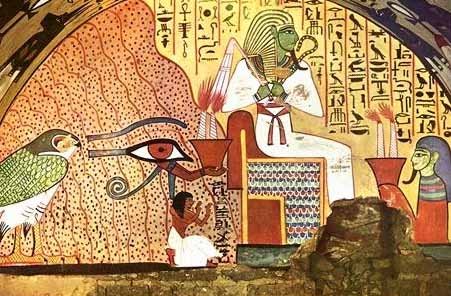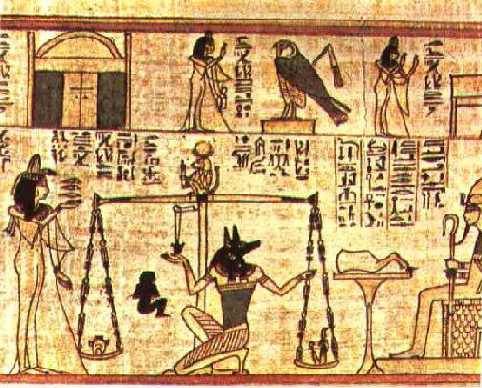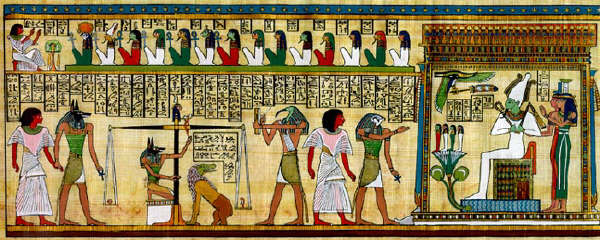Osiris is shown as a man with a beard wearing white mummy wrappings. His crown is the white crown of Upper Egypt surrounded by red feathers. He holds the symbols of supreme power, the flail and crook. His skin is green to represent vegetation. He was the God of the Dead.

Osiris was the son of Geb and Nut and was born in Thebes in Upper Egypt. Upon his birth, his grandfather, Ra, pronounced him heir to his throne, and when Geb retired, Osiris assumed this role and took his sister, Isis, as queen. His first deed was to abolish cannibalism and teach the arts of agriculture. He built the first temples and laid down fair laws for his people. He was given another name at this point, Onnophris, meaning the "good one." In his role as the fourth divine pharaoh, this was Osiris’s name.
He left Isis to rule Egypt when he decided to spread his rule around the world. He returned only after civilizing the entire earth. He found that Isis ruled wisely and his kingdom was still in perfect order. However, it was at this point that his brother, Set, began plotting against him. There are many stories of how Osiris was killed. The most common is that Set held an extravagant banquet and invited Osiris. After the festivities were over, Set produced a magnificent coffin and offered it as a gift to whomever it fitted best. Of course, it had been built for Osiris’s form and when he got in it, Set shut the lid and threw it in the Nile river.
Set took Osiris’s place as king while the grieving Isis searched for Osiris’s remains. She found the body in a far away place called Byblos, brought it back to Egypt, and hid it in the marsh. Set found it, unfortunately, and tore the body in pieces, throwing them again into the river. Isis collected all the pieces except the genitals, which had been eaten by fish. She bandaged the body together again. This was the first mummy. This mummy then transformed an akh, and this form of Osiris traveled to the underworld to become king over and judge of the dead.

Rghts to the afterlife had to be earned by righteousness, and Osiris was the judge of this. Osiris was imagined sitting on a throne in the Hall of Judgment called the "Hall of the Two Truths." The throne sat at the top of a flight of steps representing the primeval hill where Ra had been born and started creation. This hill over time had come to represent the resurrection in the afterlife. Osiris’s wife and sister, Isis was in attendance, as well as his other sister Nephthys, and his four sons, Imset, Hapy, Duamutef, and Qebehsenuf. There were forty-two judges, representing the forty-two provinces of Upper and Lower Egypt, and each judge was responsible for judging a particular aspect of conscience. Of these, there were nine great judges, and Ra was among these, as was his other form, Atum, and Shu, Tefnut, Geb, Nut, Isis, Nephthys, Horus, and Hathor.

Once the deceased had safely crossed over from the land of the living to that of the dead, he was immediately taken to the hall. This passage was considered to be the most terrifying part, and it was thought that safety could be enhanced with talismans placed on the mummy and passwords written on the indispensable Book of the Dead and sent with the deceased.
There were, it was believed, two parts to the hearing that took place next. The first was the "negative confession." The deceased addressed the gods and proclaimed himself to be sin free. (It was possible to deceive the gods.) Some say that simply saying one was pure, made one pure, like a magic spell. The second part of the hearing resulted from later beliefs that the soul really did need to be pure. This phase was presided over by Throth, god of wisdom and reason. Here, the heart of the deceased is weighed against an ostrich feather, symbol of Mayet, god of truth and justice. It is not known whether the heart of an unpure person weighed more or less than the feather, only that a pure heart weighed the same. If the heart weighed the same, the nine great judges confirmed the decision that the deceased was worthy. If not, it was thought, the deceased was thrown to Amemait the devourer, who was a hybrid monster -- part lion, part hippopotamus, part crocodile.
Once deemed worthy, the deceased was dressed in the form of Osiris and brought before the king of the dead. Osiris announced the verdict and invited the deceased to roam freely with the other gods. At this point, the deceased lived in eternal happiness, though sometimes he might be called upon to do some repair work. For this labor, he was equipped during his burial with little statuettes called "Shabtis," who would do this work for him.

The rituals of burial and passage into the afterlife were only used for the pharaohs until around the sixth dynasty. At this point, rights were extended to the pharaohs�?immediate family and the aristocracy. When this dynasty fell around 2250 B.C., this practice was used more and more by the common people as well. Until the Osiris myth came along, there was only the sun-god myth for burial and passage. This was not suited for the common person, as they did not even have access to the inner sanctuaries of Ra’s temples. The cult of the sun-god explained present day politics and was tied up in laws of ownership and inheritance of power and property. The Osiris cult appealed to the common man’s emotions and provided a way for him to believe that he, too, could have eternal life.

 Free Forum Hosting
Free Forum Hosting